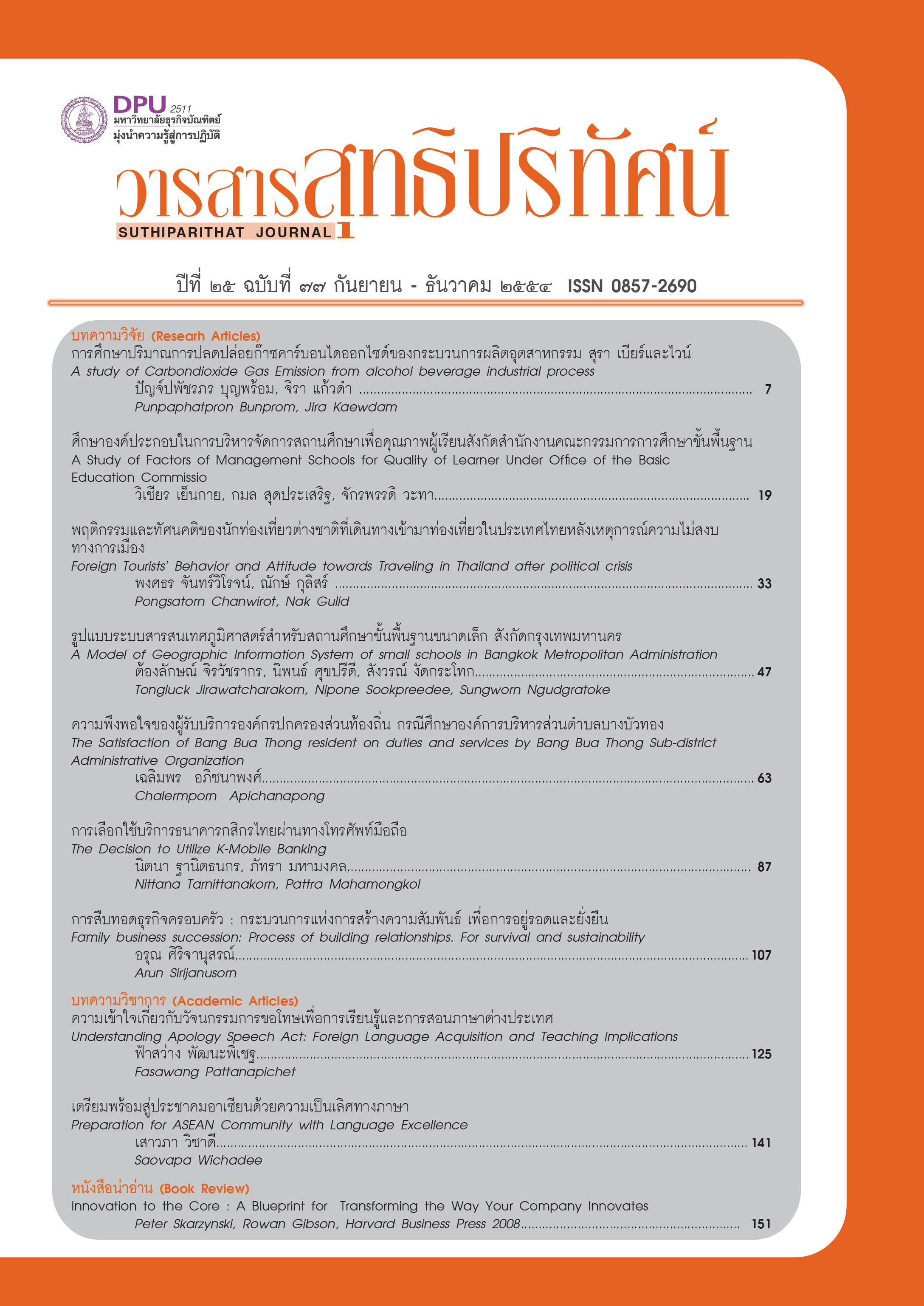การสืบทอดธุรกิจครอบครัว : กระบวนการแห่งการสร้างความสัมพันธ์เพื่อการอยู่รอดและยั่งยืน
คำสำคัญ:
ธุรกิจครอบครัว, ผลประกอบการ, การสืบทอดธุรกิจครอบครัวบทคัดย่อ
ธุรกิจครอบครัวถือเป็นรูปแบบธุรกิจพื้นฐานของระบบเศรษฐกิจในทุกประเทศทั่วโลก ปัจจัยสำคัญที่มีความสัมพันธ์กับการเติบโตและความยั่งยืนของธุรกิจครอบครัว ก็คือ ผู้สืบทอดธุรกิจของครอบครัว การศึกษานี้ต้องการค้นหาปัจจัยด้านการสืบทอดธุรกิจที่มีผลต่อการอยู่รอดและการเติบโตอย่างยั่งยืนของธุรกิจครอบครัว ด้วยการทบทวนวรรณกรรม ผลการศึกษาพบว่า การพัฒนาทายาทความสัมพันธ์ระหว่างรุ่น แผนการสืบทอดธุรกิจครอบครัวผู้ก่อตั้งหรือผู้นำ และผลตอบแทนในธุรกิจครอบครัวเป็นประเด็น สำคัญของการสืบทอดธุรกิจที่สร้างความยั่งยืนให้กับธุรกิจครอบครัว
เอกสารอ้างอิง
ตลาดหลักทรัพย์แห่งประเทศไทย. ปีต่างๆ. Fact Book. ข้อมูลสถิติการซื้อขายอสังหาริมทรัพย์. กรุงเทพฯ: ตลาดหลักทรัพย์แห่งประเทศไทย.
ตลาดหลักทรัพย์แห่งประเทศไทย. ปีต่างๆ. Fact Book. สรุปข้อสนเทศบริษัทจดทะเบียน. กรุงเทพฯ: ตลาดหลักทรัพย์แห่งประเทศไทย.
พิชิต พิทักษ์เทพสมบัติ. 2548. การสำรวจโดยการสุ่มตัวอย่าง: ทฤษฎีและปฏิบัติ. กรุงเทพฯ: คณะรัฐประศาสนศาสตร์ สถาบันบัณฑิตพัฒนบริหารศาสตร์.
ผาสุก พงษ์ไพจิต. 2549. โครงสร้างและพลวัตรของทุนไทยหลังวิกฤตเศรษฐกิจ. กรุงเทพฯ: จุฬาลงกรณ์มหาวิทยาลัย.
สำนักพัฒนาเศรษฐกิจอุตสาหกรรม. กรมส่งเสริมอุตสาหกรรม. 2544. ข้อมูลวิสาหกิจขนาดกลางและขนาดย่อมและผู้ประกอบการ. กรุงเทพฯ: กรมส่งเสริมอุตสาหกรรม.
สุรศักดิ์ ไชยธนกิจ. 2007. Evolution of Family Firms from the Perspective of Intellectual Capital Governance: Evidence from Thailand ค้นจาก. http://www.thailalndnce.eco.ku.ac.th/document/paper/4.3.pdf เมื่อวันที่ 2 กันยายน 2552.
ธงชัย สันติวงษ์. 2546. องค์การและการบริหาร: การศึกษาและการจัดการแผนใหม่. พิมพ์ครั้งที่ 8. กรุงเทพฯ: โรงพิมพ์ไทยวัฒนาพาณิช จำกัด.
เนตรนภา ไวทย์เลิศศักดิ์. 2549. กลุ่มทุนและธุรกิจครอบครัวไทยก่อนและหลังวิกฤตเศรษฐกิจ ปี 2540. กรุงเทพฯ: โรงพิมพ์จุฬาลงกรณ์มหาวิทยาลัย.
อำพล นววงศ์เสถียร. 2551. ปัจจัยที่มีผลต่อการเติบโตที่ยั่งยืนของธุรกิจครอบครัวในตลาดหลักทรัพย์แห่งประเทศไทย. วิทยานิพนธ์ดุษฎีบัณฑิต. สถาบันบัณฑิตพัฒนบริหารศาสตร์.
Aronoff. C.E. and Ward. J. L. 1997. Pay in Family Business. Nation’s Business. 85:5: 23-29.
Beckhard. R. and Dyer Jr.,W.G. 1983. SMR forum: Managing Change in the Family Firm-Issues and Strategies. Sloan Management Review. 24:3. 59-65.
Chaganti. R. and Schneer. J. A. 1994. A Study of the Impact of Owner’s Mode of Entry on Venture Performance and Management Patterns. Journal of Business Venturing. 9: 243-261.
Davis. J. H. Schoorman. F. D. and Donaldson. L. 1997. Toward a Stewardship Theory of Management. Academy of Management Review. 22:1. 20-47.
Gersick. K. E., Davis, J. A; Hampton. M. M. and Lansberg, I. 1997. Generation to Generation; Life Cycles of the Family Business. Boston, MA: Harvard Business School Press.
Harju. J. and Heinonen. J. 2004. The Keys Success in a Family Business. Turku: Turku School of Economics and Business Administration, Small Business Institute: 1-16.
Hook. C. and Trent. 1999. The Learning Organization – An Exploratory Study. Master’s thesis. University of Limerick.
Ibrahim. A. B. Soufani. K. and Lam, J. 2001. A study of Succesion in a Family Firm. Family.
Kets de Vries. M. 1993. The Dyamics of Family Controlled Firms: The Good and the Bad News. Organizational Dynamics. 21:3. 59-71.
Kukel. S. 2003. Family-Owned Business Succcess: Leveraging Advantages and Mastering Challenges. Retrieved Febuary 25, 2003 from http;//www.smallbizpartners.com/success/Xllarticles/family.html
Litz. R. A. 1995. The Family Business: toward Definitional Clarity. In Best Paper Proceedings of the Academy of Management Conference. 100-105.
Sharma. P. Chirsman. J. J. and Chua. J. H. 2003. Succession Planning as Planned Behavior Some. Empirical Results. Family Business Review. 16:1. 1-16.
Suehiro. Akira. 2001. Asia Cooperate Governance: Disclosure-Based Screening Systems and Family. Business Restructuring in Thailand. Skakai Kagaku Kenkyu. 52:2. 55-90.
Wang. Y. and Poutziouris. P. 2003. Micheal Stone Ltd. Balancing Family Tradition with Entrepreneurial Growth. In The Growing Business Handbook. Jolly. A., ed. 36thed. London: Kogan Page. 137-145.
Ward. J. 1987. Keeping the Family Business Healthy: How to Plan for Continuing Growth. Profitability and Family Leadership. San Fancisco: Jossey-Bass.
Ward. J. 1988. The Special Role of Strategic Planning for Family Businesses. Family Business Review. 1:2. 105-115.
Ward. J. 1997. Growing the Family Business: Special Challenges and Best Practices. Family Business Review. 10:4. 323-337.
Westhead. P. and Cowling. M. 1997. Performance Contrasts between Family and Non-Family Unquoted Companies in the UK. International Journal of Entrepreneurial Behavior and Research. 3:1. 30-52.
ดาวน์โหลด
เผยแพร่แล้ว
รูปแบบการอ้างอิง
ฉบับ
ประเภทบทความ
สัญญาอนุญาต
เนื้อหาและข้อมูลในบทความที่ลงตีพิมพ์ในวารสารสุทธิปริทัศน์ ถือเป็นข้อคิดเห็นและความรับผิดชอบของผู้เขียนบทความโดยตรงซึ่งกองบรรณาธิการวารสาร ไม่จำเป็นต้องเห็นด้วย หรือร่วมรับผิดชอบใด ๆ
บทความ ข้อมูล เนื้อหา รูปภาพ ฯลฯ ที่ได้รับการตีพิมพ์ในวารสารสุทธิปริทัศน์ ถือเป็นลิขสิทธิ์ของวารสารสุทธิปริทัศน์หากบุคคลหรือหน่วยงานใดต้องการนำทั้งหมดหรือส่วนหนึ่งส่วนใดไปเผยแพร่ต่อหรือเพื่อกระทำการใด ๆ จะต้องได้รับอนุญาตเป็นลายลักษณ์อักษรจากวารสารสุทธิปริทัศน์ก่อนเท่านั้น







